Which of the Following Planets Can Be Seen as a Crescent Phase From Earth?
Planetary Motions
Affiliate alphabetize in this window — — Chapter alphabetize in dissever window -- Please back up this website
Video lecture for this affiliate
At that place are other angelic objects that drift eastward with respect to the stars. They are the planets (Greek for ``wanderers''). There is much to exist learned from observing the planetary motions with simply the naked eye (i.due east., no telescope). There are 5 planets visible without a telescope, Mercury, Venus, Mars, Jupiter, and Saturn (6 if y'all include Uranus for those with sharp optics!). All of them plus Neptune move within 7 degrees of the ecliptic. This tells you something about of the orientation of the planet orbit planes with respect to the ecliptic---the effigy below shows how apartment the solar organization is when viewed forth the ecliptic airplane. The planet positions, of course, do change as they orbit the Sun, but the orbit orientations remain the aforementioned. Many of the asteroids and dwarf planets also have orbits aligned fairly well with the ecliptic (within about xxx degrees).
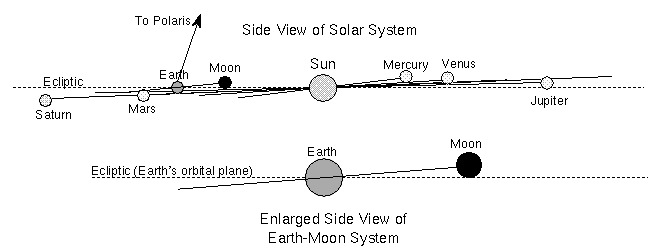
The pointer pointing to Polaris in the solar system movie is tilted by 23.5 degrees because the Earth's rotation centrality is tilted past 23.five degrees with respect to the ecliptic. As viewed from the Globe, two of the planets (Mercury and Venus) are never far from the Sun. Venus tin can get about 48 degrees from the Sun, while Mercury can only manage a 27.5 degrees separation from the Sun. This tells you something nigh the size of their orbits in relation to the Earth'south orbit size—their orbits are smaller and inside the World's orbit. When Venus and/or Mercury are east of the Sun, they will prepare after sunset so they are called an ``evening star'' even though they are not stars at all. When either of them is west of the Sun they will rising earlier sunrise and they are called a ``morning star''.
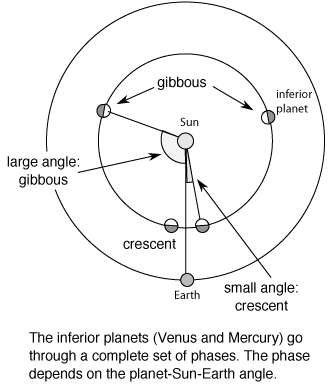
Planets produce no visible lite of their own; you see them by reflected sunlight. Truthful stars produce their own visible calorie-free. The planets inside the Earth's orbit are called the "inferior" planets because their distance from the Sun is less than (or inferior to) the Earth's distance from the Sun. Their closeness to the Sun enables united states of america to encounter them go through a complete set of phases. The figure above shows how the stage of the junior planets depends on the planet-Sun-Earth angle. The figure below gives more details of the inferior planet phases. When the planet is at the "tangent point" (where a line drawn from Earth to the planet's orbit intersects the orbit at only one point), it is at maximum separation from the Sun as seen from Earth and it appears to be in quarter phase. When the planet is farther from Earth than the tangent betoken, we see it in a gibbous phase and when it is closer to us than the tangent signal, nosotros come across the planet in a crescent phase.
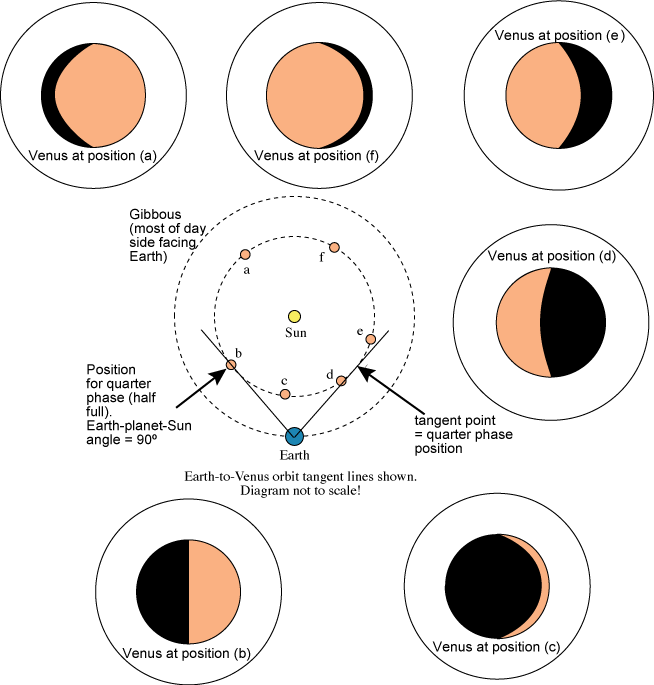
Because they can become between us and the Sun, Venus and Mercury can be seen in a crescent or new phase. This also explains why the planets outside the Earth'due south orbit, chosen the "superior planets", are never seen in a crescent or new stage. When Venus is in crescent phase, it is the brightest object in the sky besides the Moon and the Sun. Even though you see a small fraction of its sunlit side, information technology is and so close to us that y'all see it appear quite bright. At these times, Venus is brilliant enough to create a shadow! The fact that you can see Venus and Mercury also in gibbous and nearly full phase proved to be a disquisitional observation in deciding betwixt a Earth-centered model and a Sun-centered model for the solar system.
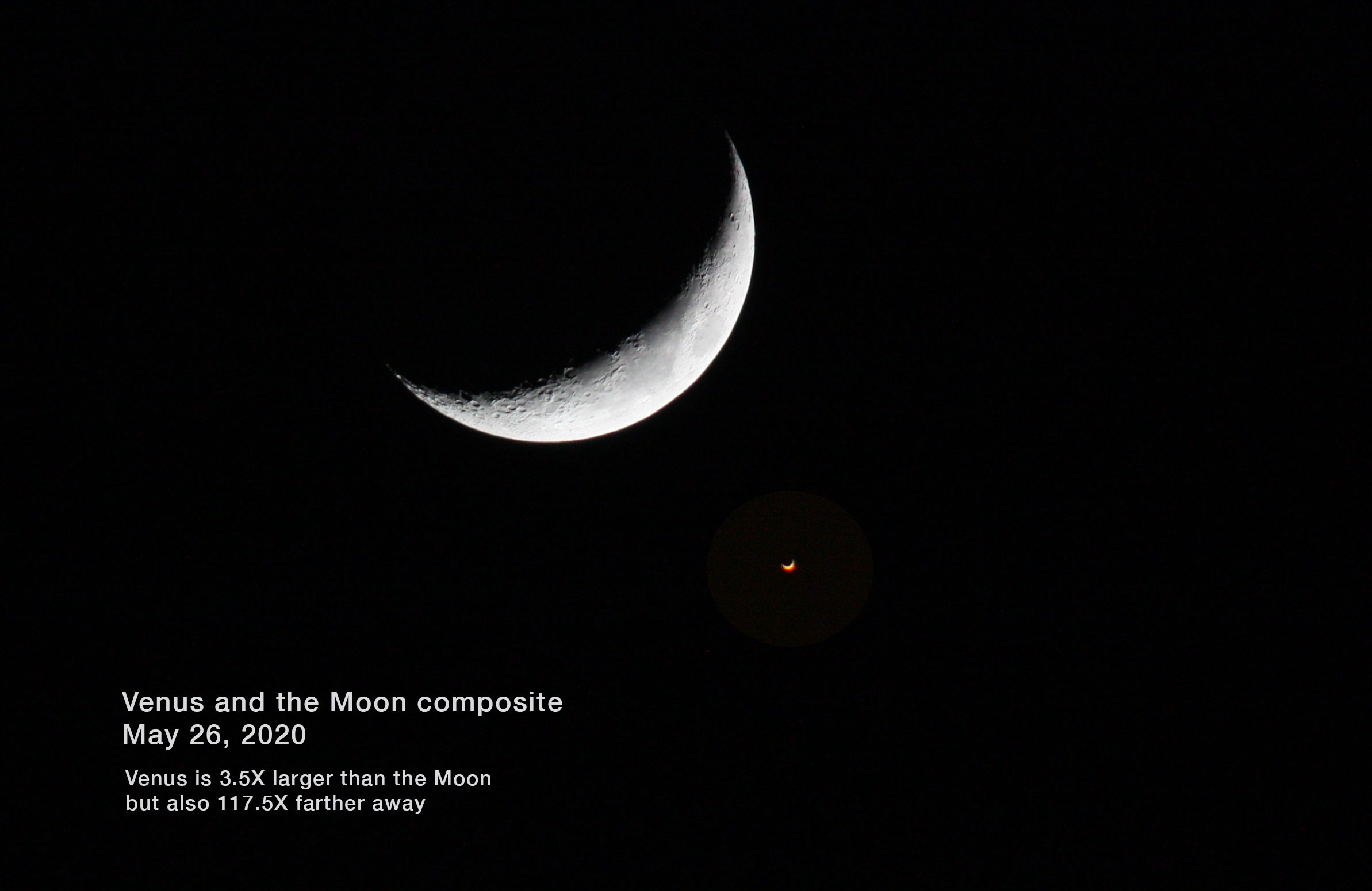
Very rarely Venus is seen to go in forepart of the Sun. Such an event is called a "transit". Venus last transited the Sun in June 2012. The next transit won't happen for another 105 years! The Venus Transit page describes the 2012 Transit, the historical significance of transits for setting the scale of the solar organization (to find the Astronomical Unit of measurement), and also how to view the Sunday safely.
Because Mercury and Venus are closer to the Sun than nosotros are (i.e., their orbits are inside the Earth's orbit), they are never visible at around midnight (or opposite the Dominicus). The superior planets tin can be visible at midnight. At midnight you are pointed directly away from the Sun and so you lot see solar system objects above the horizon that are further out from the Sunday than nosotros are. [Careful readers volition note that this is true for latitudes sufficiently far from the poles---if you are close enough to the poles, then the Lord's day can be visible at midnight and, therefore, Mercury and Venus as well.] If you want to come across where the planets are in their orbits today or whatsoever other engagement, and then go to the Solar Organization Live site (will display in another window). The orrery diagrams below illustrate the midnight view, the view for "evening star" positions, and the view for the "morning time star" positions. The evening star view shows why the "evening star" planet can be seen just in the western heaven after sunset and the morn star view shows why the "morn star" planet tin can exist seen just in the eastern sky before sunrise. Select the images to enlarge them.
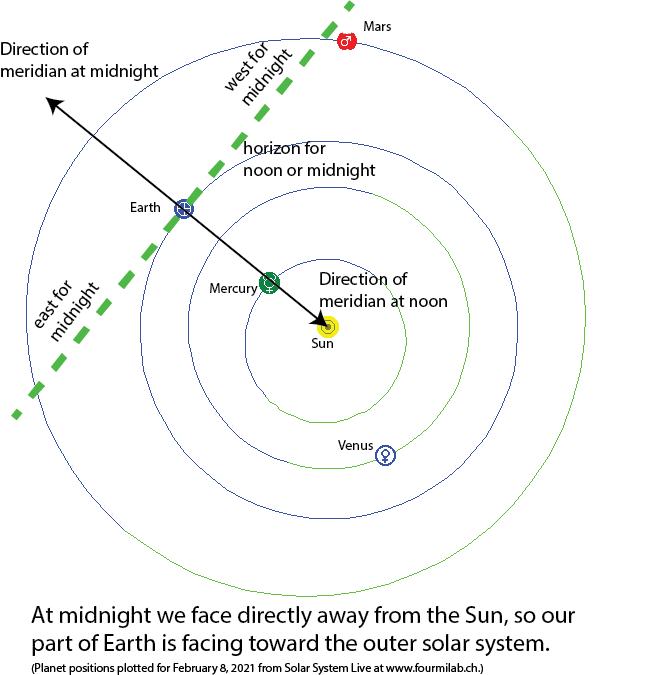 --
-- 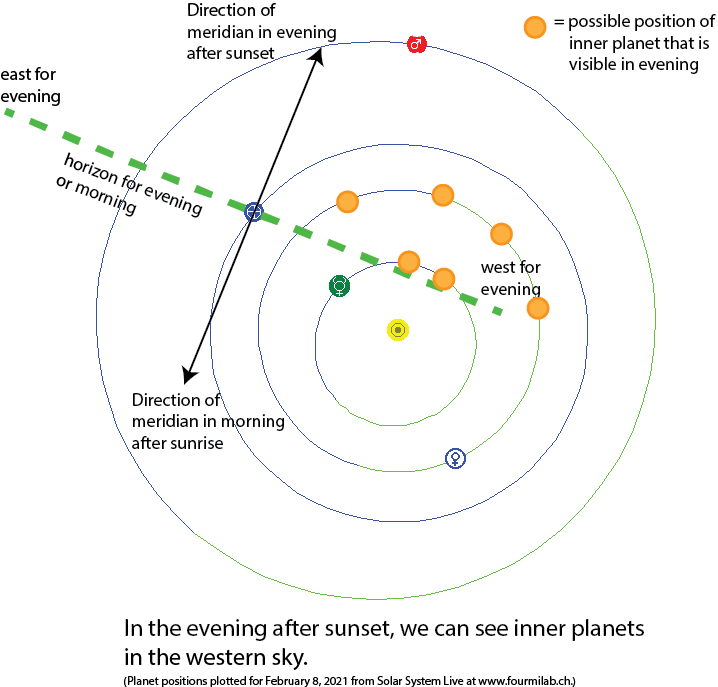 --
-- 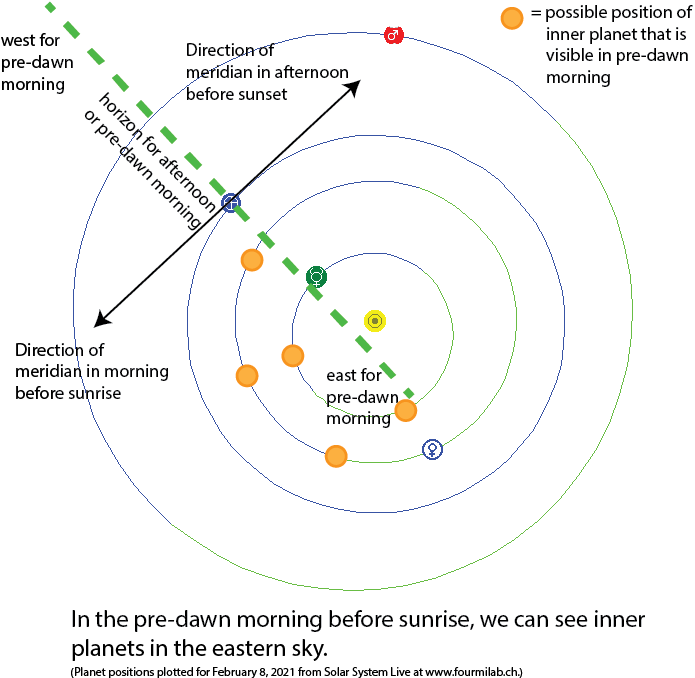
The blitheness below shows the rising, motion beyond the sky, and setting of an inner planet and an outer planet and how the observer's horizon position determines where the planets appear in the sky equally the World rotates the observer around. The animation assumes the observer is far enough north in the northern hemisphere, and so the solar arrangement objects appear in the southern heaven. In that case, objects to the right of the Sun are "ahead of" the Dominicus timewise (rising and setting earlier the Dominicus) and objects to the left of the Sunday are "backside" the Dominicus timewise (rise and setting subsequently the Lord's day). Notation that the position of the Sun in the sky (with respect to the horizon) determines the time of 24-hour interval.
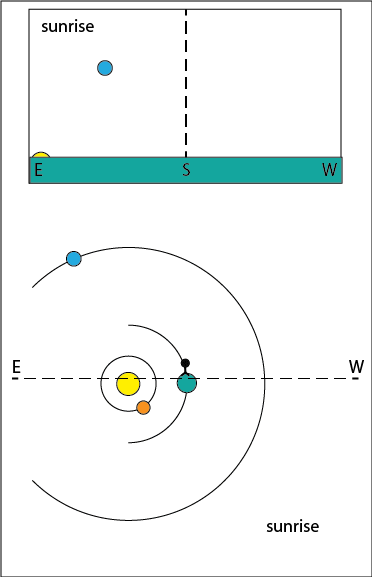
Usually the planets ``wander'' due east amid the stars (though staying shut to the ecliptic). But sometimes a strange matter happens---a planet will slow down its east migrate among the stars, halt, and then back up and head westward for a few weeks or months, then halt and move eastward over again. The planet executes a loop against the stars! When a planet is moving backward it is said to be executing retrograde move. Perhaps it seemed to the ancients that the planets wanted to accept another expect at the stars they had just passed by.
The figure beneath shows Mars' retrograde loop happening at the get-go of 1997. Mars' position is plotted every 7 days from Oct 22, 1996 (the position on November 12, 1996 is noted) and the positions at the beginning and terminate of the retrograde loop (February four and April 29, 1997) are noted. An animation of this is available here. What causes retrograde motion? The answer to that question involved a long process of cultural development, political strife, and image shifts. You will investigate the question when you lot look at geocentric (World-centered) models of the universe and heliocentric (Sun-centered) models of the universe in the next chapter.
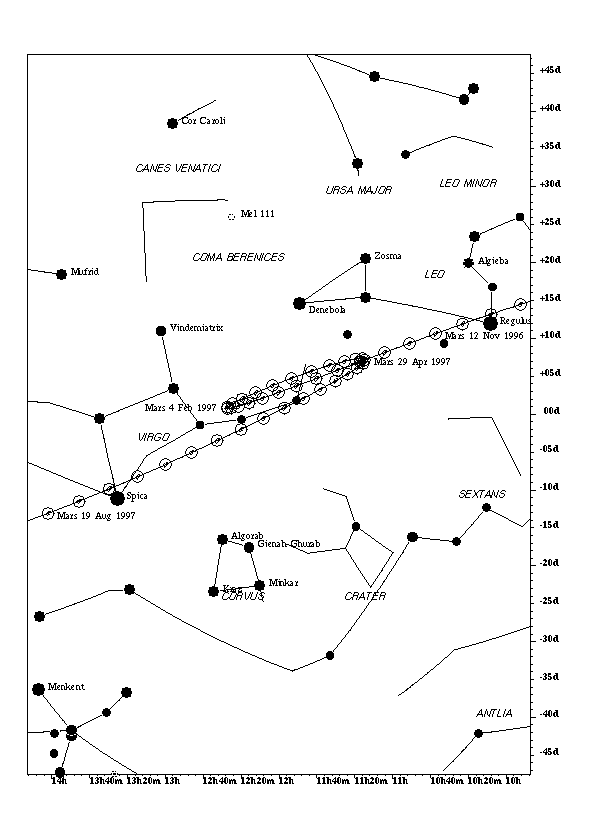
Where are the planets now?
Check out the post-obit websites to run across where the planets are right now in their orbits and where they appear in our (from World)- NASA's Center on the Solar System
- NASA'southward Solar System Exploration -- click on the orrery icon at the top of the page.
- Sky and Telescope's interactive sky nautical chart
- In the Sky's 3D Diagram of the Solar Organization
Vocabulary
retrograde motilityReview Questions
- How do the planets motility with respect to the stars?
- What does the fact that all of the planets visible without a telescope move within 7° of the ecliptic imply most the alignment of their orbital planes? What would an edge-on view of our solar organisation look similar?
- Why are Venus, and Mercury never seen at midnight while the other planets tin can be visible then?
- What phase would Venus be in when it is virtually directly between u.s.a. and the Dominicus? Where would information technology be in its orbit if nosotros see in a gibbous stage?
- Are the planet motions random all over the sky or are they restricted in some way?
 Go dorsum to previous section
Go dorsum to previous section Become to Astronomy Notes domicile
last updated: January 18, 2022
Is this folio a copy of Strobel'south Astronomy Notes?
Author of original content: Nick Strobel
Source: https://www.astronomynotes.com/nakedeye/s15.htm
0 Response to "Which of the Following Planets Can Be Seen as a Crescent Phase From Earth?"
Post a Comment